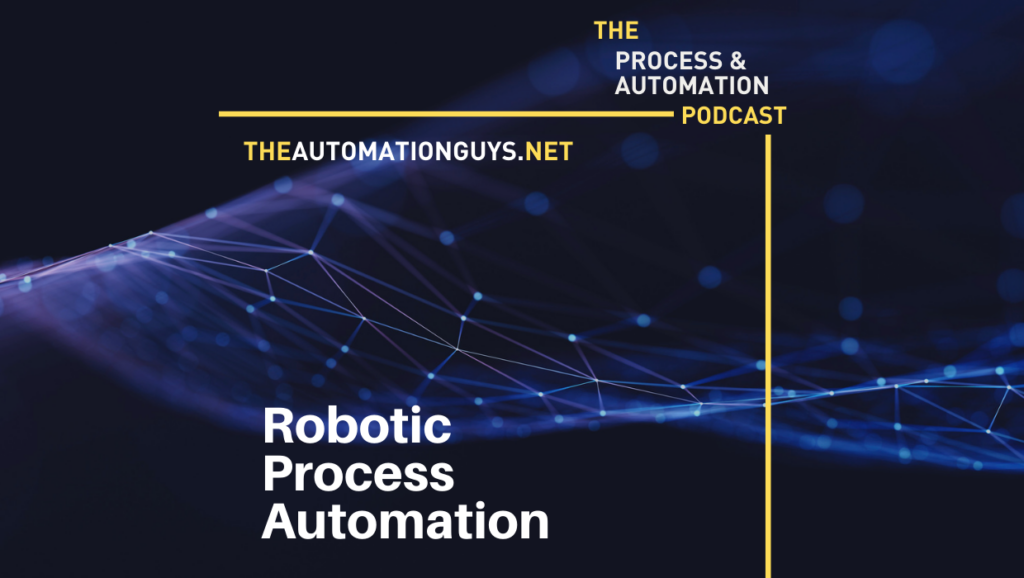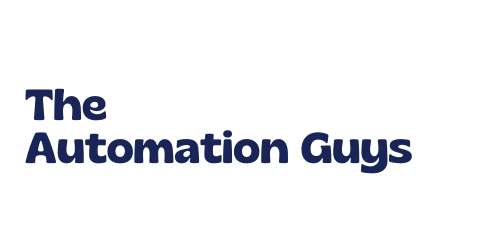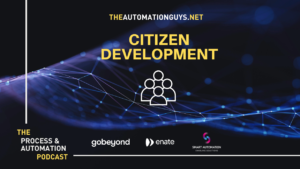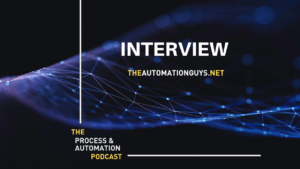Blog

What you should look for when buying a RPA platform
Share This Post
The #1 source of knowledge for everything automation: https://theautomationguys.net
Do you have any questions? Would you like to give us feedback? Are you interested in workshops on the topic of automation? Are you an expert in the field of automation and would like to be on the podcast? Let us know: https://bit.ly/3lyq9Yj
Episode Transcript
Sascha Cutura: Welcome back to another episode of The Process and Automation podcast with The Automation Guys. In today’s episode, we are looking at the topic, RPA, robotic process automation again, and we thought, um, uh, we will cover sort of a few really important points. Um, and they could, could be a checklist for everyone who is interested in RPA.
Today’s robotic process automation platforms deliver intelligent automation that does more just automating repetitive tasks. So software, RPA software solution constantly learns and performs nowadays, increasingly complex decision making. And, uh, if you are already using intelligent automation in your business, you are enjoying, I would say lots of business benefits it brings, and will want opportunities to extract more value from the platform. Uh, one of the advantages of rolling out more intelligent automation is that it doesn’t need to be a long IT project every time. So when you’re looking, looking really, um, for, for getting started, um, and looking for a cloud provider, uh, in, in that intelligent automation space. So line of business leaders, uh, and, um, groups, uh, within the center of excellence will work with the IT and procurement department, um, ensuring that that solution works for, for all of them. And, um, that’s why we, we thought, um, a quick checklist, a bias checklist for all of these areas, for the center of excellence line of business leaders and IT stakeholders would be really good to cover today. And, um, yeah, I think let’s, let’s kick off was our first section. Arno do you want to cover what the center of excellence should look for in a cloud intelligent automation solution?
Arno Van Rooyen: Yeah, that’s right. So, um, agility is the first thing we should look out for Sascha, um, business agility is obviously vital to respond or respond to, to, to changes and, you know, to keep you ahead of your competition and your Intelligent automation solution should let you, edit the processes and add new ones, uh, very quickly. It should be very easy to see, uh, you know, for example, the, the performance increase in, in, in data processing. Um, you also need to know that the business can scale quickly, you know, without incurring, um, compliancy risk, for example, so good visibility of your or business processes will obviously reduce this, this risk. Agility also comes from, I guess, empowering business users to be directly involved in, um, intelligent automation initiatives. So, you know, they can identify an action, the automation required without the need, you know, for a, for a major it project. So with little or no training, these line of business leaders must be able to quickly get up to speed with Intelligent automation through simple and intuitive interfaces. So that, so that’s kind of like the agility part of it. Reputation is a big one as well. Um, you know, in a fairly young sort of technology sector with many new and emerging players, um, coming out it’s, it is really important to invest in a partnership with a service provider that will go the distance, you know, our advise us to, to look for well-established secure providers. And of course, one way to identify likely candidates is to, you know, check out the suppliers on, on, on the analyst reports, such as IDC, Gartner. Um, you know, and, and you usually wanna look out for, for the top guard quadrants in those reports, um, you know, for, for sort of the, the, uh, industry leaders. Also talk to current users and partners.
Um, again, Gartner’s magic quadrant report, for example, mentions, um, you know, the, the partner and the customer eco systems, um, you know, so, so, so those are all kind of really important factors. The third one is, is really support. So, so what we want to do is, functionality and availability are, are key attributes, um, for, for an effective Intelligent automation solution. Obviously, you know, if you look at RPA for example, and some AI, um, modules that, that integrate with, with the RPA. So cloud delivery goes a very long way in providing reassurance on, um, those points, um, because upgrade supports and security are, are sort of baked into the platform. So you, you know, you really want to look beyond that, ensuring that there’s a strong alignment between the people and the systems, um, in, in the business and, and, and the cloud provider. You know, um, obviously defining roles and responsibilities, um, is, is important from, from the start.
And then also we wanna look at future potential. So, um, if, if you are keen to automate certain processes, um, time to value is, is really important. And then at the same time, um, you, you need to assess growth, potential. You know, you want to select a, a vendor. That’s got a great functional capability now, um, on their platform while, you know, they also should be investing in, in future enhancements.
Mm. Um, and, you know, look at the, at their sort of roadmap for their product, their willingness to, to re-evaluate and, and, and change direction where needed.
Sascha Cutura: Yeah. Awesome. Thank you. Yeah. And then the next section, uh, we have is, what IT leaders should look out for in a cloud intelligent automation platform.
So, um, when it comes to those platforms, security, is one of the number one concerns. Yeah. Um, especially, yeah, cloud based stuff it’s a number one topic indeed. And. Uh, especially when you put business critical processes and data, really outside of your corporate network, there must be really rock solid, um, uh, certainty that the cloud platform is safe and secure. So enterprise grade security and you will need to work, with the cloud provider with the intelligent automation cloud provider to secure, um, uh, connectivity. In, in full compliance, uh, with the business, um, with the compliance, um, requirements really.
And, um, yeah, the next one is around fast deployment if you’re already using, um, intelligent automation solutions, I mentioned that earlier, you’re already benefiting from lots of good stuff, fast deployments, of new process automation. Um, but cloud solutions accelerate that further provide, newcomers to intelligent automation with a fast track to adoption. And, um, yeah, when it comes to, um, to, to the cloud intelligent automation, that lets you start, uh, to automate business process pretty much instantly and instantly and demand less effort to set up and manage and maintain these environments.
Of course. Yeah. Before, when it’s not in a cloud, we have to set up all the machines ourselves, but yeah. And when it’s already ready there, then, uh, we don’t have to do that anymore. So you can move, um, really at the speed with very limited technical resources and scale up, um, very quickly, uh, when things change.
Um, yeah, the IT leaders must work alongside these cloud providers to deploy, maintain, uh, all these digital workers, bots effectively in the cloud. So it’s, it’s a good idea to define, um, exactly these responsibilities, from the get go. Then the next, the next one, um, you should check out is the connectivity and integration capabilities.
Mm-hmm um, so in the business, for example, as a CIO, uh, you are responsible for connecting the business, um, um, to these cloud solutions, and making sure there are really, really, good connections in place. Um, preconfigured, cloud deployment and digital workers that stand really ready to carry out as many processes goes a long to reducing the in-house IT workload. So, as we know, everyone is completely worked out already. There is a shortage of staff. So that should be really one big focus point when you select a new vendor.
Arno Van Rooyen: Yeah. So that’s good advice for IT leaders out there. So I guess the remaining one is what line of business leaders should look for in a cloud intelligent automation platform and lines of business leaders are, you know, service delivery managers, you know, people that look after the business. And I guess the, the, the first and most important one in my opinion is, um, they wanna look for measurable business performance improvement.
So again, if you’re a line of business leader, you probably have a very clear idea about which processes will benefit from automation and digital workers that can handle financial transactions or customer communications, for example, can work around the clock, you know, 24 7, and that obviously free up human operators to, to carry out task that add value, you know, to your customer relationship, for example. So measuring cost efficiency for this use case is, is quite straightforward. However, if you look at sort of Intelligent automation, powered business performance, performance improvements, it goes beyond achieving just hard cost efficiency, what we call hard benefits, you’ll see a very fast return on investment, not just from full-time, uh, equivalent savings, but also in the shape of key performance indicators as such customer service, customer retention. More efficient processes will enhance customer satisfaction, and you will also stand out from your competitors, and you know, this will drive your customer satisfaction statistics in the right direction. Um, so we’re talking about, um, NPA scores and satisfaction ratings, and, you know, ultimately that that would lead to higher sales and better profits, lower cost of business.
Um, so, so I guess the return on a intelligent automation investment will flow very quickly from, from several directions, you know, from high availability, uh, and up time to reduce risk of downtime and, and, and security breaches. You’ll also benefit from, you know, being able to operate 24 7 and, and allocate more digital workers very quickly to a part particular process, um, to, to meet increase demand. So, so it is sort of looking for, for that how can I measure this improvement? Um, the other one is, uh, we are looking as a line of business leader for high business impact. And again, you know, we talk about intelligent automation processes and, they really go beyond automating just routine processes.
You know, it, it really offers real potential for, for proper deep business transformation these days. Again, you’ll be able to think beyond automating just your existing processes and, and dream up really innovative, intelligent processes that can deliver, high growth or even disruptive market, you know, leaving some of your rivals to play catch up with you.
And I think that, that the right intelligent automation cloud solutions, it really offers you, uh, an opportunity to deliver a high business impact. And again, one way to identify this potential is to review, you know, the artificial intelligence and machine learning features, for example, of these solutions.
Um, you know, as well as the availability of dig digital workers, um, for example, so again, High impact that that’s what we look for. You know, it’s, it’s a, a, you know, you can understand from a, a line of business perspective, they, they are interested in, um, you know, these benefits.
Um, I guess, you know, you touched on the, the IT leader a bit, and we looked at the, the sort of what we are looking for a center of excellence. So, so it is gonna be different for kind of different stakeholders in this. So, you know, hopefully this discussion would, would, um, appeal to, to somebody in one of those personas that’s out there looking for intelligent automation and you know what to look out for when you look for a platform.
Sascha Cutura: Yeah. So the market is moving fast, isn’t it? It really makes sense to, um, when you’re starting, um, to evaluate again some players, uh, as we mentioned, they are always rated highly in the quadrants. Um, uh, but there are some movements, with maybe smaller players or we, we definitely know, uh, without sort of, uh, um, sort of recommending one specifically, but we have seen Microsoft, for example, going from hardly mentioned anywhere to become really a big leader. So this kind of movements are happening all the time and depending on what, what specific use cases need to be implemented the one player in the market is, is better than the other.
But with that checklist hopefully we can help you to make the right decisions and, yes, always reach out to, to Arno and myself, if you have any questions or like to know more, we have plenty of our episodes recorded, on the topic of RPA and also on other topics related to process and automation, intelligent automation, process mining, really, really everything. It’s really, um, useful to, to listen back to our previous episodes. Yeah. And otherwise, if you, like to stay in touch with us, um, visit us on www.theautomationguys.net and subscribe to our newsletter and we’re looking forward to welcoming you in on the next episode.
And until then let’s automate it.
Unfortunately, that’s it again, with this episode of The Process and Automation podcast. If you like this episode, please give us a five star rating and don’t forget to subscribe to this podcast, so you don’t miss any upcoming episode. We hope you will tune in next time and until then let’s automate it.
- October 5, 2022
- 7:47 pm


